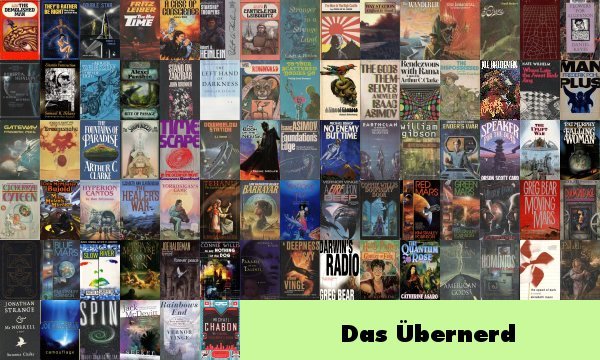
Tom Strong Book 1
Written by Alan Moore; Art by Chris Sprouse, Alan Gordon, Art Adams, Gary Frank, Dave Gibbons, and Jerry Ordway
Lettered by Todd Klein
2000 Eisner Winner for Best Single Issue (#1)
2000 Eisner Winner for Best Serialized Story (#4 - #7)
2000 Eisner Winner for Best Lettering
That's a lot of header up there and it all requires a bit of explanation. Sprouse and Gordon did most of the art in the book but the stories often contained other stories with art by a different team. In addition the individual stories are not given titles which means that I can only identify the stories that won the Eisner by their issue number.
Tom Strong is one of those comics that exist mainly to remind the reader of the past. Moore dresses his story in the style of pulp fiction and movie serials, his stories flash back to something that uses the style of comics from an earlier age, and it maintains a mostly light-hearted adventure story feeling in this first book. Tom Strong is about homaging the past, not deconstructing it. The down side to this is that Tom Strong is only really effective for readers who appreciate the homage since there's nothing else to it.
The titular Tom Strong is a scientific adventurer born on a hidden south Pacific island at the beginning of the twentieth century. He was raised from birth in a special environment that allowed him to develop physically and mentally beyond normal people. A special root found on this island keeps him young and he has spent the past century having globetrotting adventures with his family, a talking gorilla, and a steampunk robot.
The first issue is not what I'd recommend as an introduction to the series. While it tells the story of Tom's past it is done in a rather clunky method of one or two page flashbacks that are nearly all exposition. This is justified in the story as the introductory comic for Tom Strong's fan club but that doesn't make it more interesting. There are good moments in that first issue but they're caught between characters rushing through dialog explaining things they already know to each other. Between these flashbacks Tom fights some aerial bandits and while that is well told it's also nothing really special.
Then after a brief interlude of fighting some Von Neumann machines and world-hopping Aztecs there is the much better storyline that runs through issues four to seven. That features the vengence of Nazi supercriminals, the resurrection of Tom's greatest enemy, and some unexpected consequences of old adventures with a quick side trip to Pangaea. In these four issues there is the main story following the ongoing action which is broken up in each issue by a shorter story that is supposedly a Tom Strong comic from another era. So the modern comic will suddenly break into an EC-style science fiction comic or a golden age detective. While the focus of these may still be homages the style and content explodes into many new directions. Unlike the origin story and two simple adventures that preceded it this storyline integrates it's homages well. I never felt like the story was getting bogged down and while the previous three issues didn't interest me this last storyline made me want to see what happens next.
It's difficult to dislike Tom Strong because he's the earnest, good-natured heroic adventurer. For that same reason I found it really hard to like him as well. He lacks any texture beyond being an archetypal good-guy. It's especially bad early on where I was constantly asking myself why I should care about this character. The storyline that closes out the volume does give him a bit more to do as he encounters some ghosts from his past but I felt it wasn't enough.
On the other hand the secondary characters that surround Tom are a lot more interesting. They're given more opportunities to show some personality. It isn't much deeper than what Tom gets but they do get more.
I did enjoy Chris Sprouse's penciling. One interesting thing that he does is that most characters have a unique style to them. This is especially evident in the faces which seem to run the full range of styles. It's easy to see in the first issue where Tom's drawn almost cartoon like with just a few lines but has very tiny eyes. His wife and daughter are drawn in a more common comic book style. And the new member of the Tom Strong fan club looks like he came from the Sunday comics of your local newspaper.
All of the other artists who provide illustrations in the flashback do a terrific job of aping the appropriate styles with the exception of Art Adams. Adams has a World War II themed flashback and while it doesn't really look like most war comics it also features a cast of characters that seem to be custom made for his talents; it was a different choice of emphasis than the other flashbacks.
Looking over the review I have to say that I've been a bit harsher than I intended. I do like Tom Strong. I just wouldn't give it an enthusiastic recommendation. Alan Moore launched several books simultaneously with Tom Strong and it was easily the weakest of them. Much like it's contemporary The League of Extraordinary Gentlemen, Tom Strong exists almost entirely for the sake of the homage and it's impact is going to be dependent on how you respond to that homage.

